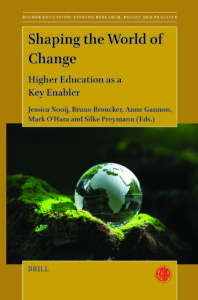12 Jun Insights into GET-AHED
Shaping the World of Change – Higher Education as a Key Enabler
This book sets out the theme of a world that is changing rapidly and higher education being an important agent in shaping that change through knowledge generation, transfer and innovation. The chapters in this book focus on this shaping role of higher education along a number of key areas: governance, sustainability, teaching and learning, student agency, quality and internationalization. From these different topics, this volume presents ways in which higher education helps dealing with and shaping the educational and societal changes that we are facing in the aftermath of the pandemic and challenges that we are expecting in the near future.
Chapter 4:
Developing a Digital Platform to Embed Environmental Sustainability in Higher Education Ecosystems. Insights into GET-AHED, a New Digital Approach
Authors:
Verena Régent, Bárbara Coelho Gabriel, Julia Draghi, Brigitte Ecker, Cláudia Figueiredo, Sara Moreno Pires, Ruaidhri Neavyn, Beate Pawle, Alexandra Polido, and Robertt Valente
Abstract
Many Higher Education Institutions (HEIs) pursue greening measures and activities, but few have fully integrated environmental sustainability into their institutional strategies. One way to support the strategic embedding of greening activities is through sustainability self-assessment. Recent studies have found existing tools lack the capacity to assess the entire university-spectrum and to facilitate HEIs’ strategic prioritisation of the topic. The EU-funded project GET-AHED aims to provide a solution and focuses on the enhancement of a HEI’s capacity to act as transformative agent of the green transition. It achieves this by providing them with a comprehensive green transition digital platform which combines three integrated tools: (i) HE Green Assessment (a holistic sustainability self-assessment tool), (ii) HE Green Champions (a training tool) and (iii) HE Green Zero (an energy efficiency tool).
This chapter focuses on the development of linkages between the underlying structures of the three tools to provide for an integrated functionality. In the case of the self-assessment tool, its primary focus are dimensions (HEI mission, functional areas and activities) and indicators (statements or questions which facilitate sustainability performance measurement) which are derived from a meta-study and qualitative analyses. Initial results show how to link these with modules (EU Green Deal pillars) of the training tool as well as with sectors envisaged with the energy efficiency tool.
More information: Shaping the World of Change – Higher Education as a Key Enabler | Brill


